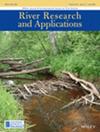美国科罗拉多河大型流域集水尺度沉积物储量估算
IF 1.7
4区 环境科学与生态学
Q4 ENVIRONMENTAL SCIENCES
引用次数: 0
摘要
从概念上讲,集水尺度的泥沙淤积量会在下游不断增加,尽管上游尺度的控制可能会超越这一趋势。我们利用文献综述中的经验数据和两个数值模型,对美国科罗拉多河流域的泥沙储量进行了定量估算。我们在 GFPLAIN 模型中使用根据 30 米数字高程模型划定的冲积层厚度和洪泛区。我们根据模型估算的 (i) 地下水储量和 (ii) 沉积物储量使用 SWAT+ 模型。现有研究表明,洪泛区和低阶地上的沉积物厚度约为 0.3-6 米。天然冲积平原的容积储量一阶近似值为每公里约 105 立方米。在长度为 101-103 米的河流中,冲积平原的泥沙储量约为 108-1011 立方米。为了进行建模估算,我们在科罗拉多河上游和下游流域内按河流顺序和海拔高度带对泥沙储量进行了评估。对各种输出结果进行比较后,我们对 GFPLAIN 和 SWAT+的含水层容积估算结果更有信心。每种方法都有很大的不确定性,只是一阶近似值。结果表明,上盆地沉积物总储存量的近似下限和上限分别为 210 亿立方米和 1300 亿立方米,下盆地沉积物总储存量的近似下限和上限分别为 3140 亿立方米和 4820 亿立方米。沉积物的最大部分储存在上盆地的山地和草原区以及下盆地的索诺拉区。本文章由计算机程序翻译,如有差异,请以英文原文为准。
Estimating catchment‐scale sediment storage in a large River Basin, Colorado River, USA
Catchment‐scale sediment storage is conceptualized as increasing in magnitude downstream, although reach‐scale controls may override this trend. We use empirical data from a literature review and two numerical models to quantitatively estimate sediment storage across the Colorado River Basin, USA. We use assumed alluvial thickness with floodplains delineated in the GFPLAIN model from 30 m digital elevation models. We use the SWAT+ model based on model‐estimated (i) groundwater storage and (ii) sediment storage. Existing studies indicate that sediment stored in floodplains and on low terraces is ~0.3–6 m thick. A first‐order approximation of volumetric storage capacity for natural floodplains is ~105 m3 per km. Sediment storage volumes of floodplains are ~108 –1011 m3 over river lengths of 101 –103 m. For the modeling estimates, we evaluated sediment storage by stream order and by elevation band within the Upper and Lower Colorado River Basins. Comparisons among the outputs cause us to place more confidence in the GFPLAIN and SWAT+ aquifer volume estimates. Each method includes substantial uncertainty and constitutes a first‐order approximation. Results suggest using 21 and 130 billion cubic meters as approximate lower and upper bounds for total sediment storage in the Upper Basin and 314 and 482 billion cubic meters as approximate lower and upper bounds for the Lower Basin. The largest proportion of sediment is stored in the montane and steppe zones in the Upper Basin and in the Sonoran zone in the Lower Basin.
求助全文
通过发布文献求助,成功后即可免费获取论文全文。
去求助
来源期刊

River Research and Applications
环境科学-环境科学
CiteScore
4.60
自引率
9.10%
发文量
158
审稿时长
6 months
期刊介绍:
River Research and Applications , previously published as Regulated Rivers: Research and Management (1987-2001), is an international journal dedicated to the promotion of basic and applied scientific research on rivers. The journal publishes original scientific and technical papers on biological, ecological, geomorphological, hydrological, engineering and geographical aspects related to rivers in both the developed and developing world. Papers showing how basic studies and new science can be of use in applied problems associated with river management, regulation and restoration are encouraged as is interdisciplinary research concerned directly or indirectly with river management problems.
 求助内容:
求助内容: 应助结果提醒方式:
应助结果提醒方式:


